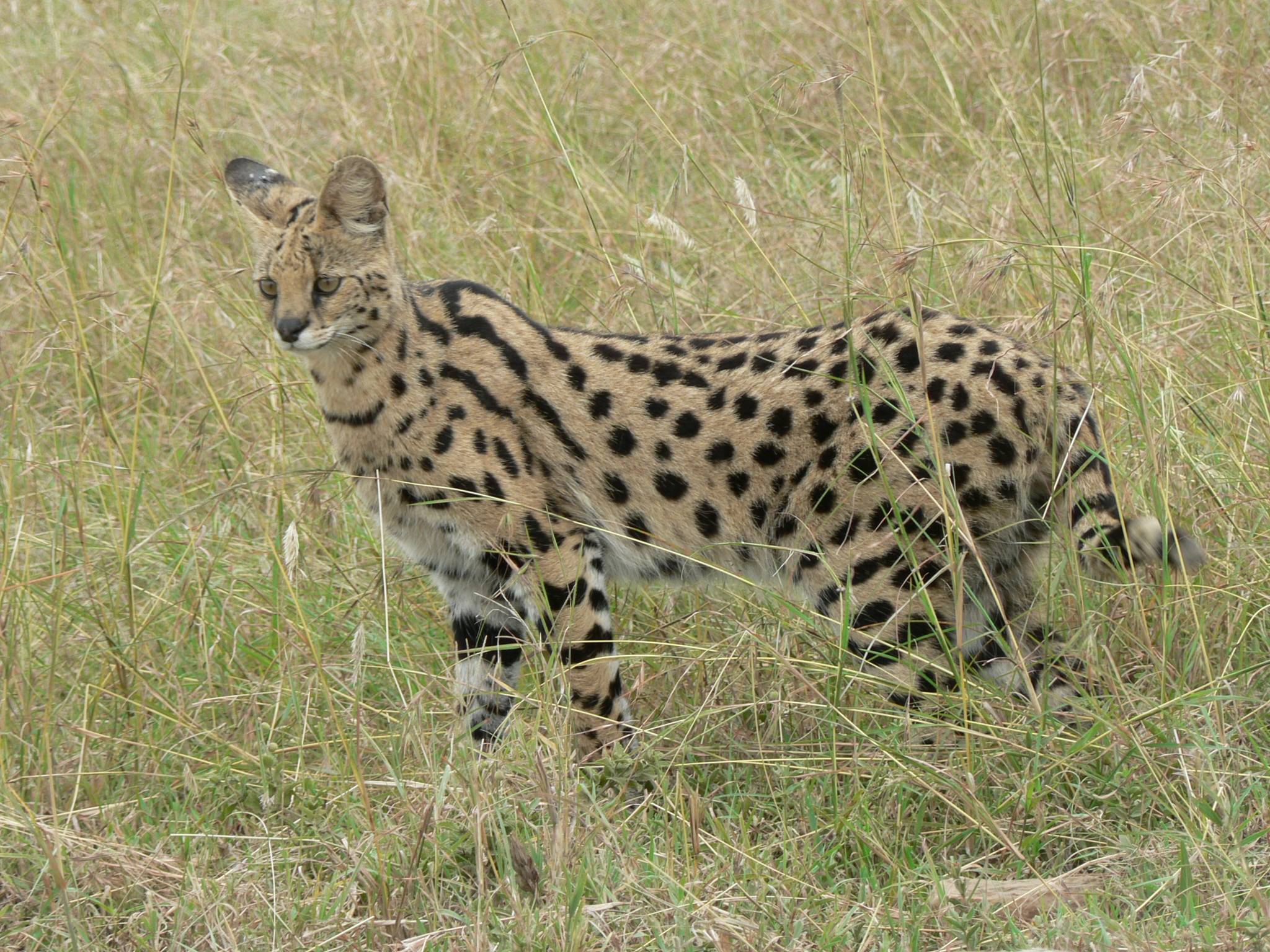Serval (Leptailurus serval) - Wiki Serval
From Wikipedia, the free encyclopedia
[Photo] Serval in Serengeti, Tanzania. Date June 2005. Photo by Budgiekiller.
The serval (Leptailurus serval) is a medium-sized African wild cat: length 85 cm, plus 40 cm tail. Life expectancy is about 12 years. It is a slender animal, with long legs and a fairly short tail. The tall, oval ears are set close together. The pattern of the fur is variable. Usually, servals are boldly spotted black on tawny. The "Servaline" form has much smaller, freckled spots. In addition melanistic servals are known to exist (see black panther). White servals are white with silvery grey spots and have only occurred in captivity.
Its main habitat is the savanna, although melanistic individuals are more usually found in mountainous areas. Servals need watercourses within their territory, so they do not live in semi-deserts or dry steppes. They are able to climb and swim, but they seldom do so. They have now dwindled down in numbers, due to human population taking over their habitat and hunting them for their pelts. They are protected in most countries. Servals are listed in CITES Appendix 2, indicating that they "not necessarily now threatened with extinction but that may become so unless trade is closely controlled."
Although the serval is highly specialzed for catching rodents, it is an opportunistic predator whose diet also includes hares, hyraxes, birds, reptiles, insects, fish, and frogs. Servals have been observed taking larger animals, such as small antelopes, but over 90% of the serval's prey weighs less than 200g (7 oz).
As part of their adaptions for hunting in the savannas, servals boast long legs (the longest of all cats, relative to body size) and large ears. The long legs and neck allow the serval to see over tall grasses, while its ears are used to detect rodents, even those burrowing underground. While hunting, servals will pause for up to 15 minutes at a time to listen with eyes closed. The serval's pounce is a distinctive vertical 'hop', which may be an adaptation for catching flushed birds. Servals are highly efficient hunters, catching prey on as many as 50% of attempts, compared to around one of ten for most species of cat.
Servals eat very quickly, sometimes eating too fast and regurgitating the food because of clogging in the throat. The litter consists of two or three young (called cubs or kittens), sometimes as few as one or as many as five. They are raised in sheltered locations like abandoned aardvark burrows. If such an ideal location is not available, a place behind a shrub may be sufficient. Servals are sometimes preyed upon by leopards. More dangerous for this cat are humans. Servals were extensively hunted for their fur. They are still common in West and East Africa, but they are extinct in the South African Cape Province and very rare north of the Sahara.
Though they are not domesticated animals, servals are sometimes kept as pets (particularly in the United States). In many countries, a special wild animal licence is required in order to keep servals. Those with experience of pet servals report them to form a strong bond with humans and to be non-aggressive towards their owners and more intelligent and active than domestic cats. Male servals have been bred to domestic cats to produce hybrids. This cross is the basis of the Savannah cat breed. Servals have also been hybridised with caracals (their closest relatives) to produce servicals and caravals.
Additionally, the Serengeti Cat is a breed being developed with the aim of producing a wild-looking domestic cat, similar in appearance to a serval in many respects, but utilizing only domestic breeds and not actually incorporating any genetic contribution from the Serval.
Subspecies
Leptailurus serval serval, Cape Province
Leptailurus serval beirae, Mozambique
Leptailurus serval brachyura, West Africa, Sahel, Ethiopia
Leptailurus serval constantina, Algeria (endangered)
Leptailurus serval hamiltoni, eastern Transvaal
Leptailurus serval hindeio, Tanzania
Leptailurus serval ingridi, Namibia, southern Botswana, Zimbabwe
Leptailurus serval kempi, Uganda
Leptailurus serval kivuensis, Congo
Leptailurus serval liposticta, northern Angola
Leptailurus serval lonnbergi, southern Angola
Leptailurus serval mababiensis, northern Botswana
Leptailurus serval robertsi, western Transvaal
Leptailurus serval togoensis, Togo, Benin
Heraldry and literature
The serval (Italian gattopardo) was the symbol of the Tomasi family, princes of Lampedusa, whose best-known member was Giuseppe Tomasi di Lampedusa, author one of the most famous Italian novels of the twentieth century, Il Gattopardo.
http://en.wikipedia.org/wiki/Serval
| The text in this page is based on the copyrighted Wikipedia article shown in above URL. It is used under the GNU Free Documentation License. You may redistribute it, verbatim or modified, providing that you comply with the terms of the GFDL. |
